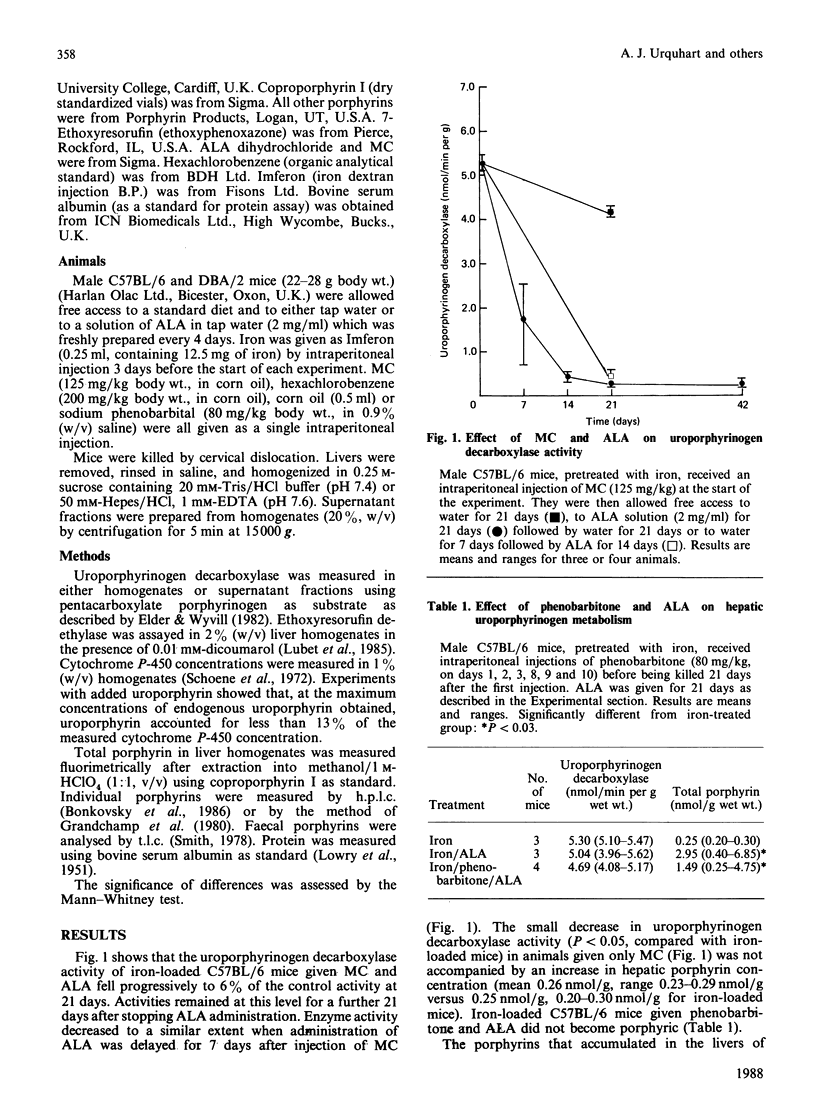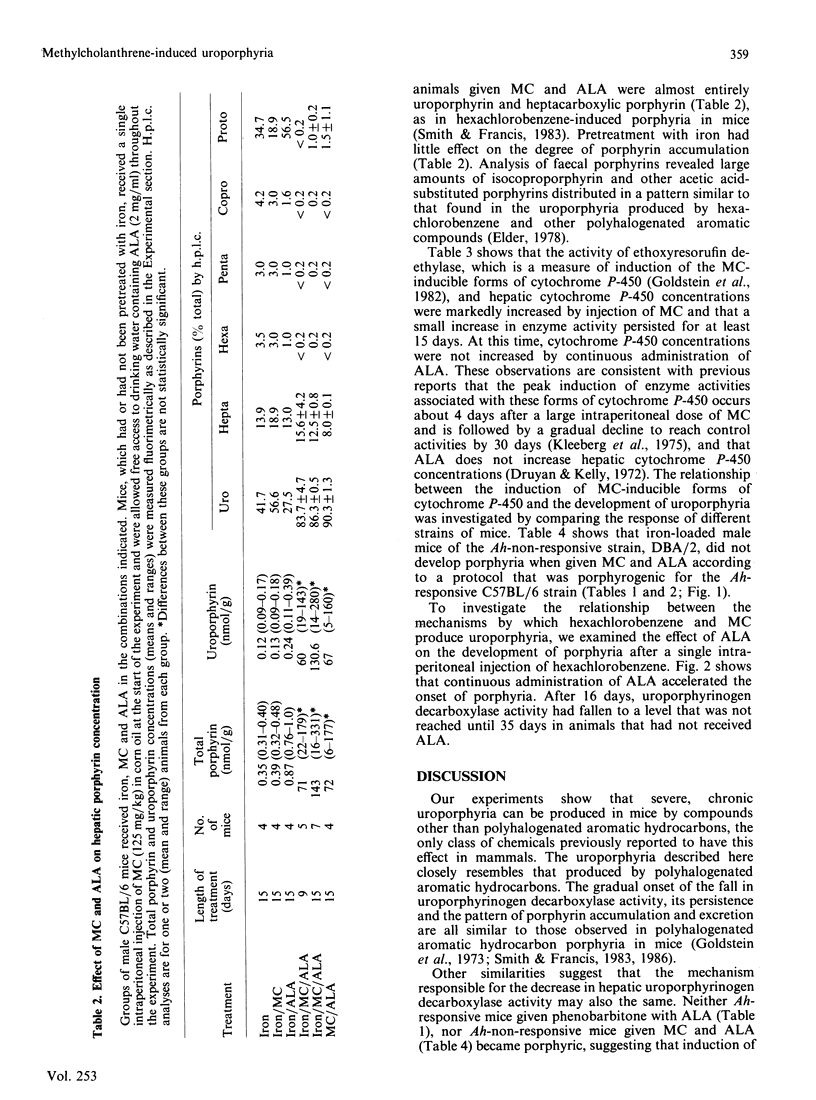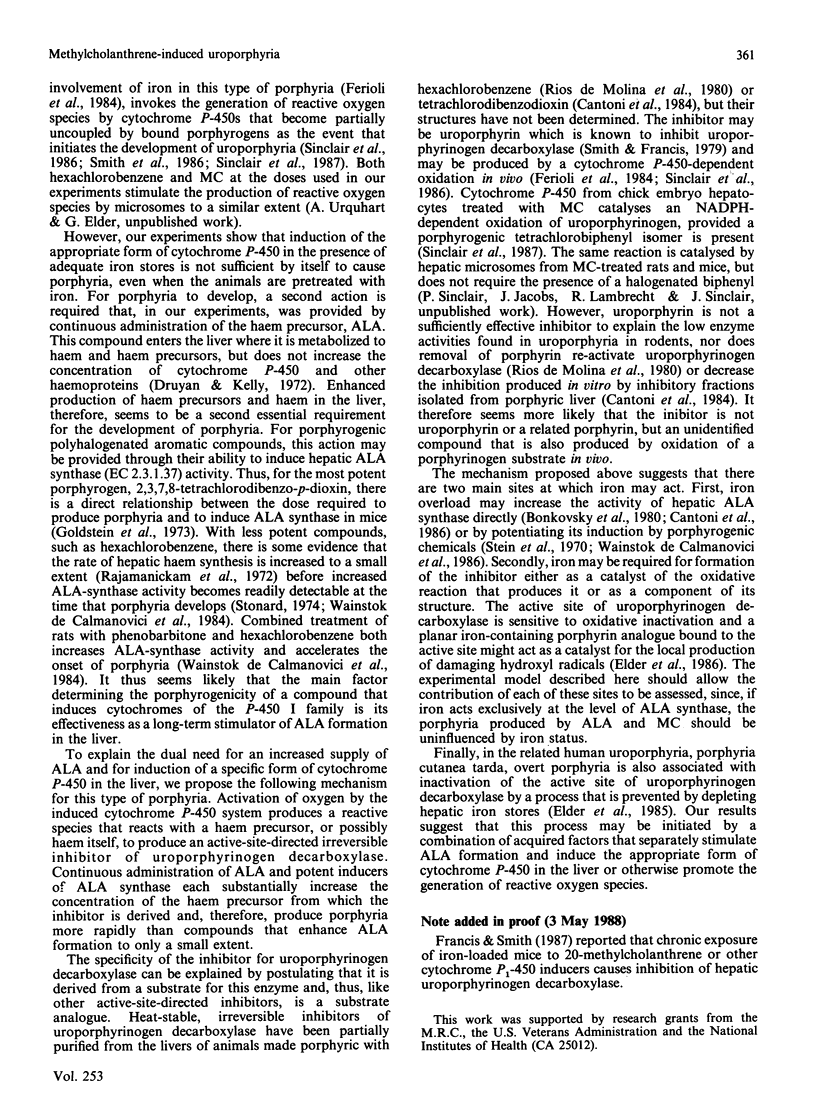Abstract
Iron-loaded male C57BL/6 mice allowed free access to an aqueous solution of 5-aminolaevulinic acid (ALA) (2 mg/ml) as their only drink, develop severe uroporphyria within 9 days of a single intraperitoneal dose of 20-methylcholanthrene (MC) (125 mg/kg). At 21 days, uroporphyrinogen decarboxylase (EC 4.1.1.37) activities are less than 10% of control activities. The porphyria is not dependent on pretreatment with iron and persists for at least 21 days after withdrawal of ALA. The same intraperitoneal dose of MC does not produce porphyria within 21 days when given without ALA. Continuous administration of ALA markedly accelerates the onset of porphyria in iron-loaded male C57BL/6 mice after a single intraperitoneal dose of hexachlorobenzene (200 mg/kg); mice given phenobarbitone and ALA do not become porphyric. MC with ALA does not produce porphyria in iron-loaded male DBA/2 mice. At least two separate events are needed to produce uroporphyria in mammals: induction of a specific form of cytochrome P-450 and stimulation of the formation of intermediates of haem biosynthesis in the liver. These results show that severe, persistent porphyria can be produced in mammals by compounds other than polyhalogenated aromatic hydrocarbons and suggest that a similar mechanism underlies the porphyrogenic action of halogenated and non-halogenated compounds.
Full text
PDF





Selected References
These references are in PubMed. This may not be the complete list of references from this article.
- Bonkovsky H. L., Wood S. G., Howell S. K., Sinclair P. R., Lincoln B., Healey J. F., Sinclair J. F. High-performance liquid chromatographic separation and quantitation of tetrapyrroles from biological materials. Anal Biochem. 1986 May 15;155(1):56–64. doi: 10.1016/0003-2697(86)90224-1. [DOI] [PubMed] [Google Scholar]
- Bonkowsky H. L., Healey J. F., Sinclair P. R., Mayer Y. P., Erny R. Metabolism of hepatic haem and 'green pigments' in rats given 2-allyl-2-isopropylacetamide and ferric citrate. A new model for hepatic haem turnover. Biochem J. 1980 May 15;188(2):289–295. doi: 10.1042/bj1880289. [DOI] [PMC free article] [PubMed] [Google Scholar]
- Cantoni L., Di Padova C., Rizzardini M., Dal Fiume D., Graziani A., Rovagnati P., Tritapepe R. Effects of iron overload on bile secretion and hepatic porphyrin metabolism in ethinyl estradiol-treated rats. Toxicology. 1986 Feb;38(2):187–196. doi: 10.1016/0300-483x(86)90119-8. [DOI] [PubMed] [Google Scholar]
- Cantoni L., dal Fiume D., Rizzardini M., Ruggieri R. In vitro inhibitory effect on porphyrinogen carboxylyase of liver extracts from TCDD treated mice. Toxicol Lett. 1984 Feb;20(2):211–217. doi: 10.1016/0378-4274(84)90149-8. [DOI] [PubMed] [Google Scholar]
- De Verneuil H., Sassa S., Kappas A. Effects of polychlorinated biphenyl compounds, 2,3,7,8-tetrachlorodibenzo-p-dioxin, phenobarbital and iron on hepatic uroporphyrinogen decarboxylase. Implications for the pathogenesis of porphyria. Biochem J. 1983 Jul 15;214(1):145–151. doi: 10.1042/bj2140145. [DOI] [PMC free article] [PubMed] [Google Scholar]
- Debets F., Reinders J. H., Koss G., Seidel J., Strik A. Effects of dietary antioxidants on the biotransformation and porphyrinogenic action of hexachlorobenzene in two strains of rats. Chem Biol Interact. 1981 Oct;37(1-2):77–94. doi: 10.1016/0009-2797(81)90167-8. [DOI] [PubMed] [Google Scholar]
- Druyan R., Kelly A. The effect of exogenous -aminolaevulinate on rat liver haem and cytochromes. Biochem J. 1972 Oct;129(5):1095–1099. doi: 10.1042/bj1291095. [DOI] [PMC free article] [PubMed] [Google Scholar]
- Elder G. H., Sheppard D. M. Immunoreactive uroporphyrinogen decarboxylase is unchanged in porphyria caused by TCDD and hexachlorobenzene. Biochem Biophys Res Commun. 1982 Nov 16;109(1):113–120. doi: 10.1016/0006-291x(82)91573-x. [DOI] [PubMed] [Google Scholar]
- Elder G. H., Urquhart A. J., De Salamanca R. E., Munoz J. J., Bonkovsky H. L. Immunoreactive uroporphyrinogen decarboxylase in the liver in porphyria cutanea tarda. Lancet. 1985 Aug 3;2(8449):229–233. doi: 10.1016/s0140-6736(85)90287-9. [DOI] [PubMed] [Google Scholar]
- Elder G. H., Wyvill P. C. Measurement of uroporphyrinogen decarboxylase using porphyrinogens prepared by chemical reduction. Enzyme. 1982;28(2-3):186–195. doi: 10.1159/000459101. [DOI] [PubMed] [Google Scholar]
- Ferioli A., Harvey C., De Matteis F. Drug-induced accumulation of uroporphyrin in chicken hepatocyte cultures. Structural requirements for the effect and role of exogenous iron. Biochem J. 1984 Dec 15;224(3):769–777. doi: 10.1042/bj2240769. [DOI] [PMC free article] [PubMed] [Google Scholar]
- Francis J. E., Smith A. G. Polycyclic aromatic hydrocarbons cause hepatic porphyria in iron-loaded C57BL/10 mice: comparison of uroporphyrinogen decarboxylase inhibition with induction of alkoxyphenoxazone dealkylations. Biochem Biophys Res Commun. 1987 Jul 15;146(1):13–20. doi: 10.1016/0006-291x(87)90683-8. [DOI] [PubMed] [Google Scholar]
- Goldstein J. A., Hickman P., Bergman H., Vos J. G. Hepatic porphyria induced by 2,3,7,8-tetrachlorodibenzo-p-dioxin in the mouse. Res Commun Chem Pathol Pharmacol. 1973 Nov;6(3):919–928. [PubMed] [Google Scholar]
- Goldstein J. A., Linko P., Huckins J. N., Stalling D. L. Structure-activity relationships of chlorinated benzenes as inducers of different forms of cytochrome P-450 in rat liver. Chem Biol Interact. 1982 Aug;41(2):131–139. doi: 10.1016/0009-2797(82)90084-9. [DOI] [PubMed] [Google Scholar]
- Grandchamp B., Deybach J. C., Grelier M., de Verneuil H., Nordmann Y. Studies of porphyrin synthesis in fibroblasts of patients with congenital erythropoietic porphyria and one patient with homozygous coproporphyria. Biochim Biophys Acta. 1980 May 22;629(3):577–586. doi: 10.1016/0304-4165(80)90163-4. [DOI] [PubMed] [Google Scholar]
- Greig J. B., Francis J. E., Kay S. J., Lovell D. P., Smith A. G. Incomplete correlation of 2,3,7,8-tetrachlorodibenzo-p-dioxin hepatotoxicity with Ah phenotype in mice. Toxicol Appl Pharmacol. 1984 Jun 15;74(1):17–25. doi: 10.1016/0041-008x(84)90265-5. [DOI] [PubMed] [Google Scholar]
- Kimura S., Gonzalez F. J., Nebert D. W. The murine Ah locus. Comparison of the complete cytochrome P1-450 and P3-450 cDNA nucleotide and amino acid sequences. J Biol Chem. 1984 Sep 10;259(17):10705–10713. [PubMed] [Google Scholar]
- Kleeberg U., Sommer M., Klinger W. Increased response of cytochrome P-450 dependent biotransformation reactions in rat liver to repeated administration of inducers. Arch Toxicol Suppl. 1985;8:361–365. doi: 10.1007/978-3-642-69928-3_74. [DOI] [PubMed] [Google Scholar]
- LOWRY O. H., ROSEBROUGH N. J., FARR A. L., RANDALL R. J. Protein measurement with the Folin phenol reagent. J Biol Chem. 1951 Nov;193(1):265–275. [PubMed] [Google Scholar]
- Linko P., Yeowell H. N., Gasiewicz T. A., Goldstein J. A. Induction of cytochrome P-450 isozymes by hexachlorobenzene in rats and aromatic hydrocarbon (Ah)-responsive mice. J Biochem Toxicol. 1986 Jun;1(2):95–107. doi: 10.1002/jbt.2570010209. [DOI] [PubMed] [Google Scholar]
- Lubet R. A., Nims R. W., Mayer R. T., Cameron J. W., Schechtman L. M. Measurement of cytochrome P-450 dependent dealkylation of alkoxyphenoxazones in hepatic S9s and hepatocyte homogenates: effects of dicumarol. Mutat Res. 1985 Mar;142(3):127–131. doi: 10.1016/0165-7992(85)90052-1. [DOI] [PubMed] [Google Scholar]
- Nebert D. W., Adesnik M., Coon M. J., Estabrook R. W., Gonzalez F. J., Guengerich F. P., Gunsalus I. C., Johnson E. F., Kemper B., Levin W. The P450 gene superfamily: recommended nomenclature. DNA. 1987 Feb;6(1):1–11. doi: 10.1089/dna.1987.6.1. [DOI] [PubMed] [Google Scholar]
- Nebert D. W., Negishi M. Multiple forms of cytochrome P-450 and the importance of molecular biology and evolution. Biochem Pharmacol. 1982 Jul 15;31(14):2311–2317. doi: 10.1016/0006-2952(82)90523-8. [DOI] [PubMed] [Google Scholar]
- Poland A., Knutson J. C. 2,3,7,8-tetrachlorodibenzo-p-dioxin and related halogenated aromatic hydrocarbons: examination of the mechanism of toxicity. Annu Rev Pharmacol Toxicol. 1982;22:517–554. doi: 10.1146/annurev.pa.22.040182.002505. [DOI] [PubMed] [Google Scholar]
- Rajamanickam C., Amrutavalli J., Rao M. R., Padmanaban G. Effect of hexachlorobenzene on haem synthesis. Biochem J. 1972 Sep;129(2):381–387. doi: 10.1042/bj1290381. [DOI] [PMC free article] [PubMed] [Google Scholar]
- Rios de Molina M. C., Wainstok de Calmanovici R., San Martin de Viale L. C. Investigations on the presence of porphyrinogen carboxy-lyase inhibitor in the liver of rats intoxicated with hexachlorobenzene. Int J Biochem. 1980;12(5-6):1027–1032. doi: 10.1016/0020-711x(80)90206-2. [DOI] [PubMed] [Google Scholar]
- Sassa S., Sugita O., Ohnuma N., Imajo S., Okumura T., Noguchi T., Kappas A. Studies of the influence of chloro-substituent sites and conformational energy in polychlorinated biphenyls on uroporphyrin formation in chick-embryo liver cell cultures. Biochem J. 1986 Apr 1;235(1):291–296. doi: 10.1042/bj2350291. [DOI] [PMC free article] [PubMed] [Google Scholar]
- Schoene B., Fleischmann R. A., Remmer H., von Oldershausen H. F. Determination of drug metabolizing enzymes in needle biopsies of human liver. Eur J Clin Pharmacol. 1972 Mar;4(2):65–73. doi: 10.1007/BF00562499. [DOI] [PubMed] [Google Scholar]
- Sinclair P. R., Bement W. J., Bonkovsky H. L., Lambrecht R. W., Frezza J. E., Sinclair J. F., Urquhart A. J., Elder G. H. Uroporphyrin accumulation produced by halogenated biphenyls in chick-embryo hepatocytes. Reversal of the accumulation by piperonyl butoxide. Biochem J. 1986 Jul 1;237(1):63–71. doi: 10.1042/bj2370063. [DOI] [PMC free article] [PubMed] [Google Scholar]
- Sinclair P. R., Bement W. J., Bonkovsky H. L., Sinclair J. F. Inhibition of uroporphyrinogen decarboxylase by halogenated biphenyls in chick hepatocyte cultures. Essential role for induction of cytochrome P-448. Biochem J. 1984 Sep 15;222(3):737–748. doi: 10.1042/bj2220737. [DOI] [PMC free article] [PubMed] [Google Scholar]
- Sinclair P., Lambrecht R., Sinclair J. Evidence for cytochrome P450-mediated oxidation of uroporphyrinogen by cell-free liver extracts from chick embryos treated with 3-methylcholanthrene. Biochem Biophys Res Commun. 1987 Aug 14;146(3):1324–1329. doi: 10.1016/0006-291x(87)90794-7. [DOI] [PubMed] [Google Scholar]
- Smith A. G., Cabral J. R., De Matteis F. A difference between two strains of rats in their liver non-haem iron content and in their response to the porphyrogenic effect of hexachlorobenzene. Chem Biol Interact. 1979 Oct;27(2-3):353–363. doi: 10.1016/0009-2797(79)90138-8. [DOI] [PubMed] [Google Scholar]
- Smith A. G., Francis J. E. Decarboxylation of porphyrinogens by rat liver uroporphyrinogen decarboxylase. Biochem J. 1979 Nov 1;183(2):455–458. doi: 10.1042/bj1830455. [DOI] [PMC free article] [PubMed] [Google Scholar]
- Smith A. G., Francis J. E., Kay S. J., Greig J. B., Stewart F. P. Mechanistic studies of the inhibition of hepatic uroporphyrinogen decarboxylase in C57BL/10 mice by iron-hexachlorobenzene synergism. Biochem J. 1986 Sep 15;238(3):871–878. doi: 10.1042/bj2380871. [DOI] [PMC free article] [PubMed] [Google Scholar]
- Smith A. G., Francis J. E. Synergism of iron and hexachlorobenzene inhibits hepatic uroporphyrinogen decarboxylase in inbred mice. Biochem J. 1983 Sep 15;214(3):909–913. doi: 10.1042/bj2140909. [DOI] [PMC free article] [PubMed] [Google Scholar]
- Smith S. G. The use of thin layer chromatography in the separation of free porphyrins and porphyrin methyl esters. Br J Dermatol. 1975 Sep;93(3):291–295. doi: 10.1111/j.1365-2133.1975.tb06494.x. [DOI] [PubMed] [Google Scholar]
- Stein J. A., Tschudy D. P., Corcoran P. L., Collins A. Delta-aminolevulinic acid synthetase. 3. Synergistic effect of chelated iron on induction. J Biol Chem. 1970 May 10;245(9):2213–2218. [PubMed] [Google Scholar]
- Stewart F. P., Smith A. G. Metabolism and covalent binding of hexachlorobenzene by isolated male and female rat hepatocytes. Biochem Pharmacol. 1987 Jul 1;36(13):2232–2234. doi: 10.1016/0006-2952(87)90158-4. [DOI] [PubMed] [Google Scholar]
- Stonard M. D. Experimental hepatic porphyria induced by hexachlorobenzene as a model for human symptomatic porphyria. Br J Haematol. 1974 Aug;27(4):617–625. doi: 10.1111/j.1365-2141.1974.tb06628.x. [DOI] [PubMed] [Google Scholar]
- Sweeny G. D., Jones K. G., Cole F. M., Basford D., Krestynski F. Iron deficiency prevents liver toxicity of 2,3,7,8-tetrachlorodibenzo-p-dioxin. Science. 1979 Apr 20;204(4390):332–335. doi: 10.1126/science.432648. [DOI] [PubMed] [Google Scholar]
- Taljaard J. J., Shanley B. C., Deppe W. M., Joubert S. M. Prophyrin metabolism in experimental hepatic siderosis in the rat. II. Combined effect of iron overload and hexachlorobenzene. Br J Haematol. 1972 Oct;23(4):513–519. doi: 10.1111/j.1365-2141.1972.tb07086.x. [DOI] [PubMed] [Google Scholar]
- Wainstock de Calmanovici R., Billi S. C., Aldonatti C. A., San Martín de Viale L. C. Effect of desferrioxamine on the development of hexachlorobenzene-induced porphyria. Biochem Pharmacol. 1986 Jul 15;35(14):2399–2405. doi: 10.1016/0006-2952(86)90467-3. [DOI] [PubMed] [Google Scholar]
- Wainstok de Calmanovici R., Ríos de Molina M. C., Taira de Yamasato M. C., Tomio J. M., San Martin de Viale L. C. Mechanism of hexachlorobenzene-induced porphyria in rats. Effect of phenobarbitone pretreatment. Biochem J. 1984 Mar 15;218(3):753–763. doi: 10.1042/bj2180753. [DOI] [PMC free article] [PubMed] [Google Scholar]


